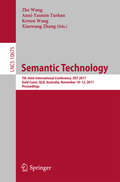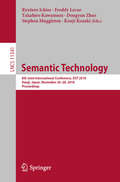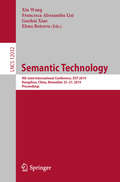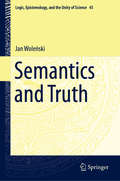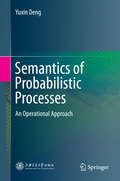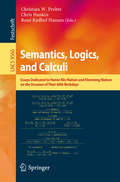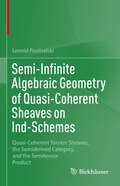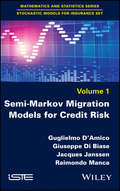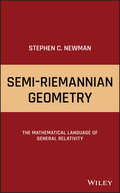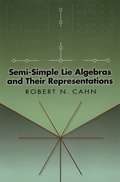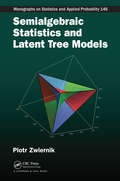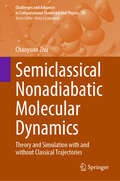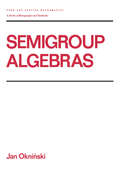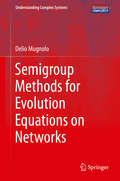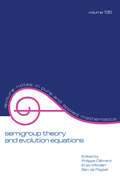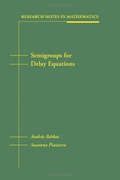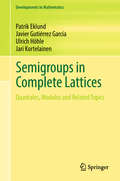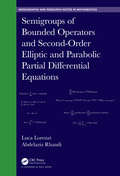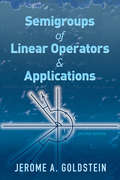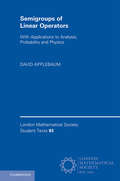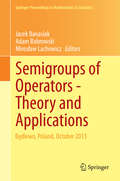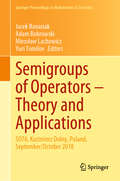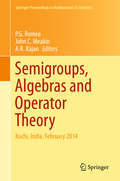- Table View
- List View
Semantic Technology: 7th Joint International Conference, JIST 2017, Gold Coast, QLD, Australia, November 10-12, 2017, Proceedings (Lecture Notes in Computer Science #10675)
by Zhe Wang Anni-Yasmin Turhan Kewen Wang Xiaowang ZhangThis book constitutes the thoroughly refereed proceedings of the 7th Joint International Semantic Technology Conference, JIST 2017, held in Goldcoast, QLD, Australia, in November 2017. The 19 full papers and 4 short papers presented were carefully reviewed and selected from 37 submissions. They present applications of semantic technologies, theoretical results, new algorithms and tools to facilitate the adoption of semantic technologies and are organized in topical sections on ontology and data management; ontology reasoning; linked data and query; information retrieval and knowledge discovery; knowledge graphs; and applications of semantic technologies.
Semantic Technology: 8th Joint International Conference, JIST 2018, Awaji, Japan, November 26–28, 2018, Proceedings (Lecture Notes in Computer Science #11341)
by Kouji Kozaki Dongyan Zhao Freddy Lecue Ryutaro Ichise Takahiro Kawamura Stephen MuggletonThis book constitutes the thoroughly refereed proceedings of the 8th Joint International Semantic Technology Conference, JIST 2018, held in Awaji, Japan, in November 2018. The 23 full papers and 6 short papers presented were carefully reviewed and selected from 75 submissions. They present applications of semantic technologies, theoretical results, new algorithms and tools to facilitate the adoption of semantic technologies and are organized in topical sections on knowledge graphs; data management; question answering and NLP; ontology and reasoning; government open data; and semantic web for life sciences.
Semantic Technology: 9th Joint International Conference, JIST 2019, Hangzhou, China, November 25–27, 2019, Proceedings (Lecture Notes in Computer Science #12032)
by Xin Wang Francesca Alessandra Lisi Guohui Xiao Elena BotoevaThis book constitutes the thoroughly refereed proceedings of the 9th Joint International Semantic Technology Conference, JIST 2019, held in Hangzhou, China, in November 2019. The 24 full papers presented were carefully reviewed and selected from 70 submissions. They present applications of semantic technologies, theoretical results, new algorithms and tools to facilitate the adoption of semantic technologies and are organized in topical sections on knowledge graphs; data management; question answering and NLP; ontology and reasoning; government open data; and semantic web for life sciences.
Semantics and Truth (Logic, Epistemology, and the Unity of Science #45)
by Jan WoleńskiThe book provides a historical (with an outline of the history of the concept of truth from antiquity to our time) and systematic exposition of the semantic theory of truth formulated by Alfred Tarski in the 1930s. This theory became famous very soon and inspired logicians and philosophers. It has two different, but interconnected aspects: formal-logical and philosophical. The book deals with both, but it is intended mostly as a philosophical monograph. It explains Tarski’s motivation and presents discussions about his ideas (pro and contra) as well as points out various applications of the semantic theory of truth to philosophical problems (truth-criteria, realism and anti-realism, future contingents or the concept of correspondence between language and reality).
Semantics of Probabilistic Processes
by Yuxin DengThis book discusses the semantic foundations of concurrent systems with nondeterministic and probabilistic behaviour. Particular attention is given to clarifying the relationship between testing and simulation semantics and characterising bisimulations from metric, logical, and algorithmic perspectives. Besides presenting recent research outcomes in probabilistic concurrency theory, the book exemplifies the use of many mathematical techniques to solve problems in computer science, which is intended to be accessible to postgraduate students in Computer Science and Mathematics. It can also be used by researchers and practitioners either for advanced study or for technical reference.
Semantics, Logics, and Calculi
by Christian W. Probst Chris Hankin René Rydhof HansenThis Festschrift volume is published in honorof Hanne Riis Nielson and Flemming Nielson on the occasion of their 60thbirthdays in 2014 and 2015, respectively. The papers included in this volumedeal with the wide area of calculi, semantics, and analysis. The book features contributions fromcolleagues, who have worked together with Hanne and Flemming through theirscientific life and are dedicated to them and to their work. The papers werepresented at a colloquium at the Technical University of Denmark in January2016.
Semi-Infinite Algebraic Geometry of Quasi-Coherent Sheaves on Ind-Schemes: Quasi-Coherent Torsion Sheaves, the Semiderived Category, and the Semitensor Product
by Leonid PositselskiSemi-Infinite Geometry is a theory of "doubly infinite-dimensional" geometric or topological objects. In this book the author explains what should be meant by an algebraic variety of semi-infinite nature. Then he applies the framework of semiderived categories, suggested in his previous monograph titled Homological Algebra of Semimodules and Semicontramodules, (Birkhäuser, 2010), to the study of semi-infinite algebraic varieties. Quasi-coherent torsion sheaves and flat pro-quasi-coherent pro-sheaves on ind-schemes are discussed at length in this book, making it suitable for use as an introduction to the theory of quasi-coherent sheaves on ind-schemes. The main output of the homological theory developed in this monograph is the functor of semitensor product on the semiderived category of quasi-coherent torsion sheaves, endowing the semiderived category with the structure of a tensor triangulated category. The author offers two equivalent constructions of the semitensor product, as well as its particular case, the cotensor product, and shows that they enjoy good invariance properties. Several geometric examples are discussed in detail in the book, including the cotangent bundle to an infinite-dimensional projective space, the universal fibration of quadratic cones, and the important popular example of the loop group of an affine algebraic group.
Semi-Markov Migration Models for Credit Risk
by Jacques Janssen Raimondo Manca Giuseppe Di Biase Guglielmo D'AmicoCredit risk is one of the most important contemporary problems for banks and insurance companies. Indeed, for banks, more than forty percent of the equities are necessary to cover this risk. Though this problem is studied by large rating agencies with substantial economic, social and financial tools, building stochastic models is nevertheless necessary to complete this descriptive orientation.This book presents a complete presentation of such a category of models using homogeneous and non-homogeneous semi-Markov processes developed by the authors in several recent papers. This approach provides a good method of evaluating the default risk and the classical VaR indicators used for Solvency II and Basel III governance rules.This book is the first to present a complete semi-Markov treatment of credit risk while also insisting on the practical use of the models presented here, including numerical aspects, so that this book is not only useful for scientific research but also to managers working in this field for banks, insurance companies, pension funds and other financial institutions.
Semi-Riemannian Geometry: The Mathematical Language of General Relativity
by Stephen C. NewmanAn introduction to semi-Riemannian geometry as a foundation for general relativity Semi-Riemannian Geometry: The Mathematical Language of General Relativity is an accessible exposition of the mathematics underlying general relativity. The book begins with background on linear and multilinear algebra, general topology, and real analysis. This is followed by material on the classical theory of curves and surfaces, expanded to include both the Lorentz and Euclidean signatures. The remainder of the book is devoted to a discussion of smooth manifolds, smooth manifolds with boundary, smooth manifolds with a connection, semi-Riemannian manifolds, and differential operators, culminating in applications to Maxwell’s equations and the Einstein tensor. Many worked examples and detailed diagrams are provided to aid understanding. This book will appeal especially to physics students wishing to learn more differential geometry than is usually provided in texts on general relativity. STEPHEN C. NEWMAN is Professor Emeritus at the University of Alberta, Edmonton, Alberta, Canada. He is the author of Biostatistical Methods in Epidemiology and A Classical Introduction to Galois Theory, both published by Wiley.
Semi-Simple Lie Algebras and Their Representations
by Robert N. CahnDesigned to acquaint students of particle physiME already familiar with SU(2) and SU(3) with techniques applicable to all simple Lie algebras, this text is especially suited to the study of grand unification theories. Author Robert N. Cahn, who is affiliated with the Lawrence Berkeley National Laboratory in Berkeley, California, has provided a new preface for this edition. Subjects include the killing form, the structure of simple Lie algebras and their representations, simple roots and the Cartan matrix, the classical Lie algebras, and the exceptional Lie algebras. Additional topiME include Casimir operators and Freudenthal's formula, the Weyl group, Weyl's dimension formula, reducing product representations, subalgebras, and branching rules. 1984 edition.
Semialgebraic Statistics and Latent Tree Models
by Piotr ZwiernikThe first part of the book gives a general introduction to key concepts in algebraic statistics, focusing on methods that are helpful in the study of models with hidden variables. The author uses tensor geometry as a natural language to deal with multivariate probability distributions, develops new combinatorial tools to study models with hidden data, and describes the semialgebraic structure of statistical models.The second part illustrates important examples of tree models with hidden variables. The book discusses the underlying models and related combinatorial concepts of phylogenetic trees as well as the local and global geometry of latent tree models. It also extends previous results to Gaussian latent tree models.This book shows you how both combinatorics and algebraic geometry enable a better understanding of latent tree models. It contains many results on the geometry of the models, including a detailed analysis of identifiability and the defining polynomial constraints
Semiclassical Nonadiabatic Molecular Dynamics: Theory and Simulation with and without Classical Trajectories (Challenges and Advances in Computational Chemistry and Physics #38)
by Chaoyuan ZhuThis book shows how to derive the simple and accurate semiclassical methods analytically and its applications to excited-state molecular dynamics and spectroscopy simulation with and without classical trajectories. It consists of eight chapters demonstrating interesting conical and intersystem-driven photochemical processes in complex systems targeting on large-scale ab initio direct nonadiabatic molecular dynamics. It also includes two chapters dealing with time-independent and time-dependent nonadiabatic molecular dynamics and clarifies the underline principle of Born–Oppenheimer approximation associated with coherence/decoherence quantum effects that have a wide range of applications in photochemistry and photophysics. This book is interesting and useful to a wide readership in the various fields of basic quantum chemistry and physics associated with large-scale excited-state simulation of nonadiabatic molecular dynamics and spectroscopy.
Semiclassical and Stochastic Gravity: Quantum Field Effects on Curved Spacetime (Cambridge Monographs on Mathematical Physics)
by Bei-Lok B. Hu Enric VerdaguerThe two pillars of modern physics are general relativity and quantum field theory, the former describes the large scale structure and dynamics of space-time, the latter, the microscopic constituents of matter. Combining the two yields quantum field theory in curved space-time, which is needed to understand quantum field processes in the early universe and black holes, such as the well-known Hawking effect. This book examines the effects of quantum field processes back-reacting on the background space-time which become important near the Planck time (10-43 sec). It explores the self-consistent description of both space-time and matter via the semiclassical Einstein equation of semiclassical gravity theory, exemplified by the inflationary cosmology, and fluctuations of quantum fields which underpin stochastic gravity, necessary for the description of metric fluctuations (space-time foams). Covering over four decades of thematic development, this book is a valuable resource for researchers interested in quantum field theory, gravitation and cosmology.
Semigroup Algebras
by Jan OkninskiGathers and unifies the results of the theory of noncommutative semigroup rings, primarily drawing on the literature of the last 10 years, and including several new results. Okninski (Warsaw U., Poland) restricts coverage to the ring theoretical properties for which a systematic treatment is current
Semigroup Methods for Evolution Equations on Networks
by Delio MugnoloThis concise text is based on a series of lectures held only a few years ago and originally intended as an introduction to known results on linear hyperbolic and parabolic equations. Yet the topic of differential equations on graphs, ramified spaces, and more general network-like objects has recently gained significant momentum and, well beyond the confines of mathematics, there is a lively interdisciplinary discourse on all aspects of so-called complex networks. Such network-like structures can be found in virtually all branches of science, engineering and the humanities, and future research thus calls for solid theoretical foundations. This book is specifically devoted to the study of evolution equations - i. e. , of time-dependent differential equations such as the heat equation, the wave equation, or the Schrödinger equation (quantum graphs) - bearing in mind that the majority of the literature in the last ten years on the subject of differential equations of graphs has been devoted to elliptic equations and related spectral problems. Moreover, for tackling the most general settings - e. g. encoded in the transmission conditions in the network nodes - one classical and elegant tool is that of operator semigroups. This book is simultaneously a very concise introduction to this theory and a handbook on its applications to differential equations on networks. With a more interdisciplinary readership in mind, full proofs of mathematical statements have been frequently omitted in favor of keeping the text as concise, fluid and self-contained as possible. In addition, a brief chapter devoted to the field of neurodynamics of the brain cortex provides a concrete link to ongoing applied research.
Semigroup Theory and Evolution Equations: The Second International Conference
by Ben De Pagter Philippe Clément Enzo MitidieniProceedings of the Second International Conference on Trends in Semigroup Theory and Evolution Equations held Sept. 1989, Delft University of Technology, the Netherlands. Papers deal with recent developments in semigroup theory (e.g., positive, dual, integrated), and nonlinear evolution equations (e
Semigroups for Delay Equations
by Andras Batkai Susanna PiazzeraIn most physical, chemical, biological and economic phenomena it is quite natural to assume that the system not only depends on the present state but also on past occurrences. These circumstances are mathematically described by partial differential equations with delay. This book presents, in a systematic fashion, how delay equations can be studied
Semigroups in Complete Lattices: Quantales, Modules and Related Topics (Developments in Mathematics #54)
by Patrik Eklund Javier Gutiérrez García Ulrich Höhle Jari KortelainenThis monograph provides a modern introduction to the theory of quantales. First coined by C.J. Mulvey in 1986, quantales have since developed into a significant topic at the crossroads of algebra and logic, of notable interest to theoretical computer science. This book recasts the subject within the powerful framework of categorical algebra, showcasing its versatility through applications to C*- and MV-algebras, fuzzy sets and automata. With exercises and historical remarks at the end of each chapter, this self-contained book provides readers with a valuable source of references and hints for future research. This book will appeal to researchers across mathematics and computer science with an interest in category theory, lattice theory, and many-valued logic.
Semigroups of Bounded Operators and Second-Order Elliptic and Parabolic Partial Differential Equations (Chapman & Hall/CRC Monographs and Research Notes in Mathematics)
by Luca Lorenzi Adbelaziz RhandiSemigroups of Bounded Operators and Second-Order Elliptic and Parabolic Partial Differential Equations aims to propose a unified approach to elliptic and parabolic equations with bounded and smooth coefficients. The book will highlight the connections between these equations and the theory of semigroups of operators, while demonstrating how the theory of semigroups represents a powerful tool to analyze general parabolic equations. Features Useful for students and researchers as an introduction to the field of partial differential equations of elliptic and parabolic types Introduces the reader to the theory of operator semigroups as a tool for the analysis of partial differential equations
Semigroups of Linear Operators and Applications: Second Edition (Dover Books on Mathematics)
by Jerome A. GoldsteinThis advanced monograph of semigroup theory explores semigroups of linear operators and linear Cauchy problems. Suitable for graduate students in mathematics as well as professionals in science and engineering, the treatment begins with an introductory survey of the theory and applications of semigroups of operators. Two main sections follow, one dedicated to semigroups of linear operators, and the other to linear Cauchy problems. Author Jerome A. Goldstein emphasizes motivation and heuristics as well as applications. Each of the two sections concludes with further applications and historical notes. Challenging exercises appear throughout the text, which includes a substantial bibliography. This edition has been updated with supplementary transcripts of five lectures given by the author during a 1989 workshop at Blaubeuren, Germany.
Semigroups of Linear Operators: With Applications to Analysis, Probability and Physics (London Mathematical Society Student Texts #93)
by David ApplebaumThe theory of semigroups of operators is one of the most important themes in modern analysis. Not only does it have great intellectual beauty, but also wide-ranging applications. In this book the author first presents the essential elements of the theory, introducing the notions of semigroup, generator and resolvent, and establishes the key theorems of Hille–Yosida and Lumer–Phillips that give conditions for a linear operator to generate a semigroup. He then presents a mixture of applications and further developments of the theory. This includes a description of how semigroups are used to solve parabolic partial differential equations, applications to Levy and Feller–Markov processes, Koopmanism in relation to dynamical systems, quantum dynamical semigroups, and applications to generalisations of the Riemann–Liouville fractional integral. Along the way the reader encounters several important ideas in modern analysis including Sobolev spaces, pseudo-differential operators and the Nash inequality.
Semigroups of Operators -Theory and Applications
by Jacek Banasiak Adam Bobrowski Mirosław LachowiczMany results, both from semi group theory itself and from the applied sciences, are phrased in discipline-specific languages and hence are hardly known to a broader community. This volume contains a selection of lectures presented at a conference that was organised as a forum for all mathematicians using semi group theory to learn what is happening outside their own field of research. The collection will help to establish a number of new links between various sub-disciplines of semigroup theory, stochastic processes, differential equations and the applied fields. The theory of semigroups of operators is a well-developed branch of functional analysis. Its foundations were laid at the beginning of the 20th century, while the fundamental generation theorem of Hille and Yosida dates back to the forties. The theory was, from the very beginning, designed as a universal language for partial differential equations and stochastic processes, but at the same time it started to live as an independent branch of operator theory. Nowadays, it still has the same distinctive flavour: it develops rapidly by posing new 'internal' questions and in answering them, discovering new methods that can be used in applications. On the other hand, it is influenced by questions from PDEs and stochastic processes as well as from applied sciences such as mathematical biology and optimal control, and thus it continually gathers a new momentum. Researchers and postgraduate students working in operator theory, partial differential equations, probability and stochastic processes, analytical methods in biology and other natural sciences, optimization and optimal control will find this volume useful.
Semigroups of Operators – Theory and Applications: SOTA, Kazimierz Dolny, Poland, September/October 2018 (Springer Proceedings in Mathematics & Statistics #325)
by Jacek Banasiak Adam Bobrowski Mirosław Lachowicz Yuri TomilovThis book features selected and peer-reviewed lectures presented at the 3rd Semigroups of Operators: Theory and Applications Conference, held in Kazimierz Dolny, Poland, in October 2018 to mark the 85th birthday of Jan Kisyński. Held every five years, the conference offers a forum for mathematicians using semigroup theory to discover what is happening outside their particular field of research and helps establish new links between various sub-disciplines of semigroup theory, stochastic processes, differential equations and the applied fields. The book is intended for researchers, postgraduate and senior students working in operator theory, partial differential equations, probability and stochastic processes, analytical methods in biology and other natural sciences, optimisation and optimal control.The theory of semigroups of operators is a well-developed branch of functional analysis. Its foundations were laid at the beginning of the 20th century, while Hille and Yosida’s fundamental generation theorem dates back to the forties. The theory was originally designed as a universal language for partial differential equations and stochastic processes but, at the same time, it started to become an independent branch of operator theory. Today, it still has the same distinctive character: it develops rapidly by posing new ‘internal’ questions and, in answering them, discovering new methods that can be used in applications. On the other hand, it is being influenced by questions from PDE’s and stochastic processes as well as from applied sciences such as mathematical biology and optimal control and, as a result, it continually gathers new momentum. However, many results, both from semigroup theory itself and the applied sciences, are phrased in discipline-specific languages and are hardly known to the broader community.
Semigroups, Algebras and Operator Theory
by P. G. Romeo John C. Meakin A. R. RajanThis book discusses recent developments in semigroup theory and its applications in areas such as operator algebras, operator approximations and category theory. All contributing authors are eminent researchers in their respective fields, from across the world. Their papers, presented at the 2014 International Conference on Semigroups, Algebras and Operator Theory in Cochin, India, focus on recent developments in semigroup theory and operator algebras. They highlight current research activities on the structure theory of semigroups as well as the role of semigroup theoretic approaches to other areas such as rings and algebras. The deliberations and discussions at the conference point to future research directions in these areas. This book presents 16 unpublished, high-quality and peer-reviewed research papers on areas such as structure theory of semigroups, decidability vs. undecidability of word problems, regular von Neumann algebras, operator theory and operator approximations. Interested researchers will find several avenues for exploring the connections between semigroup theory and the theory of operator algebras.
Semigroups, Algebras and Operator Theory: ICSAOT 2022, CUSAT, India, March 28–31 (Springer Proceedings in Mathematics & Statistics #436)
by A. A. Ambily V. B. Kiran KumarThis book contains chapters on a range of topics in mathematics and mathematical physics, including semigroups, algebras, operator theory and quantum mechanics, most of them have been presented at the International Conference on Semigroup, Algebras, and Operator Theory (ICSAOT-22), held at Cochin, Kerala, India, from 28–31 March 2022. It highlights the significance of semigroup theory in different areas of mathematics and delves into various themes that demonstrate the subject’s diverse nature and practical applications. One of the key features of the book is its focus on the relationship between geometric algebra and quantum mechanics. The book offers both theoretical and numerical approximation results, presenting a comprehensive overview of the subject. It covers a variety of topics, ranging from C∗-algebraic models to numerical solutions for partial differential equations. The content of the book is suitable for active researchers and graduate students who are just beginning their studies in the field. It offers insights and practical applications that would be valuable to anyone interested in the mathematical foundations of physics and related fields. Overall, this book provides an excellent resource for anyone seeking to deepen their understanding of the intersections between mathematics and physics.
